Notes from MDI for use in preparing senior review of SOHO operations,
data processing, data analysis, and science investigations for FY02-05
I. Contents
 II. Previous Senior Review
II. Previous Senior Review
The SOHO Prime Mission was from April 1996 through April 1998. The SOHO program
was reviewed along with other operating missions in the NASA SEC Theme in
June 1997. The result of that review was approval to continue SOHO
operations and science analysis for what was called the SOHO Solar Maximum
Science Program. Part of the reccommendation was for the instrument team
co-investigators to be funded via an expanded Guest-Investigator program.
While the SOHO instrument teams were funded at or near the necessary levels
to accomplish the goals of the solar maximum program the Guest Investigator
program was not adequately funded. As a result, a number of the analysis
projects we counted on proceeded on shoestring budgets with fewer results
than had been hoped. Nevertheless, we as a team, have made significant
progress toward the goals outlined in 1997 and have made discoveries
in areas not anticipated in the prior review. The near loss of SOHO
in 1998 and resultant intermittent operations into Feb 1999 also caused
a significant loss in momentum and a break in continuity that delayed
some of the investigations requiring continuity such as the g-mode
search and the cycle evolution of fields and flows.
The
Previous Review Links
contain the SOHO Solar Maximum Science Program proposal and
the report and reccommendations of the Senior Review Panel.
The proposal outlined major accomplishements for helioseismology as:
- Helioseismology
-
The first ever image of the convection zone of a star shows that
convective cells in the Sun are shaped like pancakes, not spheres as
assumed in mixing-length theory
-
Differential rotation continues in depth to the bottom of the
convection zone.
-
Below the convection zone the Sun rotates as a solid sphere.
-
There is a narrow shear zone at the bottom of the convection
zone where the interior is very turbulent - this is the most
likely region for the generation of the solar dynamo.
And it summarized the
topics for SOHO Solar Maximum interval:
- Helioseismology
-
Determine whether we can probe the deepest interior of the
Sun with g-modes and low-l p-modes
-
Observe how the interior and convective transport evolve with
the solar cycle and study the interaction between the magnetic
cycle and the shear zone
-
Understand where and how the dynamo really works
 III. MDI Science Contributions
III. MDI Science Contributions
MDI successfully provided observations leading to discoveries and
progress in understanding of a number of topics during the SOHO prime
mission and extended phases.
MDI data has contributed to at least 12 PhD dissertations, made significant
contribution to at least 15 symposia and workshops with
refereed proceedings, and provided data for at least 458 papers as of March 2001.
Of the papers,
there were 13, 43, 142, 98, 120, and 42 in 1996-2001 respectively.
Since the 1997 Senior Review MDI contributed to several new discoveries.
There is not space here to review them all so only a few are listed here.
The full list of papers is linked below.
- New constraints on interior rotation and sound-speed profiles (Schou
et al., 1998; Birch & Kosovichev, 1998; Dziembowski et al, 1998;
Kosovichev et al., 1997, 1998; Toutain et al. 1998).
- Migration of zonal flows (Schou 1999, Howe et al, 2000b).
- Zonal flows with depth (Kosovichev and Schou, 1997; Schou et al., 1998).
- Slow polar rotation (Birch and Kosovichev, 1998).
- Tachocline shear variations (Howe et al, 2000)
- Meridional flow with depth (Giles et al., 1997; Schou & Bogart, 1998;
González Hernández, 1998).
- Meridional flow varies with cycle (Giles dissertation, 1999).
- Precise measurement of the seismic radius (Schou et al., 1997).
- Shape of limb (Kuhn et al, 1998)
- Assymmetries of p-mode spectrum lines, source of oscillations
( e.g. Nigam, et al., 1997, Nigam et al, 1998, Kumar and Basu 1999)
- Relativistic corrections to the equation of state (Elliott
& Kosovichev, 1998).
- Studies on nature of supergranulation (Hathaway et al, 2000,
Beck & Schou 2000, Beck & Duvall 2001)
- Detection of Giant Cells (Beck et al.,1998).
- Detection of seismic response to flares (Kosovichev & Zharkova, 1998).
- Thermal structure beneath sunspots (Kosovichev, Duvall & Scherrer, 1997).
- Flows beneath sunspots (e.g. Kosovichev et al, 2001).
- Accoustic glories etc. (Donea et al, 2000)
- Farside imaging (Lindsey & Braun, 2000)
- Ordered large scale flows toward active regions (Gizon et al., 2001).
- Upper limits to g-mode amplitudes (Appourchaux et al. 2000)
Of the 20 items above, at least 13 were primarily accomplished or had
significant contributions by Guest Investigators.
A number of MDI results have produced interesting visual results.
Some of these are available in the
MDI "Nice" Image Collection
for use as needed by the MDI community.
 IV. Proposed Investigations
IV. Proposed Investigations
There are many science investigation topics presently proceeding
with the support of MDI observations. The range of topics presently
under investigation is similar to the topics in the hundreds of papers
published to date. Some sample studies that require continued MDI
observations in the declining and near minimum phases of the present
cycle are described here.
-
We have evidence of large scale organized subsurface (near surface)
flows toward active regions. We have samples from 97, 98, 99
from MDI dynamics where there was data and activity. 96 was too
quiet and 2000 had not enough data to make a clean statement.
These samples are only 2 rotations each so we do not yet know how
these flows evolve and relate to the growth/decay phases of
activity. But some samples in the declining phase are important to
obtain - else we have to wait until 2012 to get that info - and
it may be very helpful to understand the emergence and decay processes
of active regions.
Flows Toward Active Regions

|
Horizontal flow map obtained for part of rotation 1949 (in 1999) after
subtraction of a smooth rotation background. Arrows are plotted
every 3.84 degrees. Mean travel times shorter than average (dark shade,
up to 3% relative change) are associated with magnetic activity.
(From Gizon, IAU 203, 2000)
|
- The structure beneath surface fields
The increase in wave speed beneath magnetic fields is now well established
(Kosovichev, et al., 1997, Lindsey & Braun 1999).
First seen in pre-SOHO observations by Duvall et al. (1993), and familiar
to many via the "Coffee-Cup Picture" featured on the early NASA Living With A Star
documents, the faster wave speed is seen beneath spots, plage, and pores.
Wave Speed Beneath A Sunspot
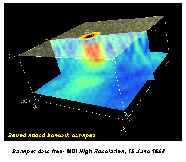
|
The accoustic wave speed beneath the spot in the high resolution field of view
in June 1998. Redder colors are faster and bluer colors are slower. Detailed
views show "fingers" of faster speed connect nearby same-polarity pores at
a depth of about 3 Mm. This image is also available in
postscript.
|
Work done by Junwei Zhao confirms suggestions from Duvall and Kosovichev that
there is an ordered flow beneath large spots.
This data is from J. Zhao, A. Kosovichev, and T. Duvall (2001)
from a new analysis. It is consistent with a previous
analysis using a less robust technique bu Kosovichev et al (2000)
which resulted in the "coffee cup" figure.
Flows Beneath A Sunspot
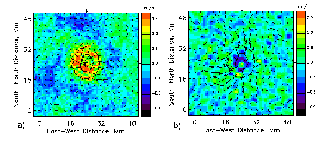
|
Motion beneath a spot. These figures show material flows at the depth
of 0-3 Mm (a) and at 6-9 Mm (b). The data is
from the 19 June 1998 spot in the MDI high resolution field.
The outline of the sunspot umbra and penumbra is shown.
The colors are vertical motion with
positive values (red) corresponding to downflow.
The arrows are horizonatl motion. The longest arrows
correspond to 1.0 km/s in (a) and 1.6 km/s in (b).
Also in postscript.
|
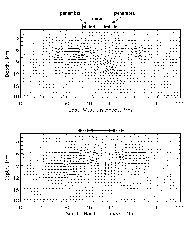
|
Vertical cuts through the 19 June 1998 sunspot.
The arows show flow speeds with the longest arrows representing
1.4 km/s. The combination of figure 2 and 3 show
a converging flow pattern in the first 3-4 Mm beneath
the spot and a diverging flow from 6 to 9 Mm. There is
a downflow centered on the umbra near the surface
turning into an upflow below about 9 Mm.
A weak upflow is also seen at the edge of the moat
flow in the upper layers.
Also in postscript.
|
-
We have evidence of variations in the shear at the tachocline and
some suggestions of variations in poleward flow and perhaps
longitudinal variation in the near surface shear. These are all
important to understand the cycle and may vary in different phases
of the cycle. Again, we would very much like to see what happens
in the declining phase/begining of next cycle which happens in
the next 2-4 years.
The tachocline (shear layer at the base of the convection zone) near
the equator shows variations in the strength of the shear with about
a 1.3 year period. This variation is not yet understood and its
implications are not yet understood. It has withstood a number of
tests of reality and the result remains intact. We await more years to
see what happens in the declining phase. The figure below is from
Howe et al (2000).
Variations in Shear at the Tachocline

|
The cutaway shows rotation shear strength. In the inner region red and blue show
faster and slower rotation while in the surface layers red and green are used to show slower and faster. The variations near the base of the convection zone are up to 20% of the shear. A mpeg
movie shows
this variation in time.
|
The existance of a poleward flow of 10-20 m/s has been known for 2 cycles but only with
MDI observations has it been well characterized and observed to extend
at least 10% into the convection zone.
See e.g. Giles et al. (1998) or Hernández
et al. (1998) for details.
There is a suggestion in the data that the poleward flow extends only to lower
latitudes in the years nearer to maximum. This possible variation with
the cycle is a topic of current investigation.
-
We know that the surface and near surface rotation at the
poles shows some variation over the cycle - from comparing Big Bear
helioseismology data with MDI data. What we can now learn is
just what this change is and how it relates to the uniformity
of the polar fields. This is in part related to the zonal flow
study in the upper part of the convection zone - accessible to MDI but not
from the ground. Birch and Kosovichev (1998) have examined the
near-pole rotation and look forward to extending the study into
the declining phase. (GONG+ may also be able to contribute here.)
-
Lindsey and Braun (2000) demonstrated that phase sensitive
accoustic imaging techniques
(essentially the same as the time-distance method)
can be used to image magnetic regions on the farside of the Sun.
We have just begun to experiment with making farside flux estimates on
a daily basis using MDI medium-l continuous Dopplergram data.
This data is available each day in near real time and can be used to
detect changes in activity a week or more before it rotates onto the
Earth facing solar hemisphere.
The images here show the whole Sun 27 and 13.5 days before region 9393 was
at disk center. It is clear that this region, which produced a strong geo-effective
CME and the largest flare in more than a decade (aurora in Mexico), was
visible for more than a week before it rotated onto the disk. There was
little hint of it when that longitude was Earth-facing in the prior rotation.
We would like to learn how to make these predictive images better and to study
if they can be of use in planning for observations as well as learn if
they are useful for projecting activity levels for other purposes.
Geoeffectiveness of CMEs
CMEs are only geoeffective when they contain or drive several
hours of southward Bz when they arrive at Earth.
Estimates of the orientation of fields pushed by CMEs show that
the pre-existing
field estimates for the overlying corona make good predictions of
the Bz when the locations of Earth directed CMEs are known (e.g. Zhao & Hoeksema, 1997).
Recent developments in processing of MDI magnetograms has led to
the concept of "synoptic frame" where synoptic whole-Sun Carrington grids of
magnetic field are suplemented by rapidly updated magnetic information
for the visible disk. Initial analyses of these data are promising
and may lead to better estimates of the sign and strength of the Bz
component of the field carried by CMEs.
Tools to use this data is presently being developed at UC Berkeley.
See: sample use.
The synoptic maps using the 96minute magnetograms are prepared daily
for planning purposes.
Some notes on the geo-effectiveness of CME's.
Daily Synoptic Magnetic Map
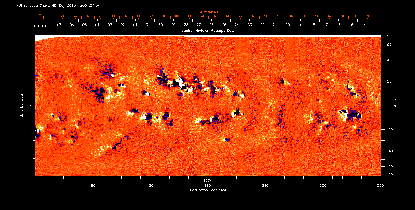
|
|
Extended Cycle
Evidence shows the visible part of the cycle is something like
18 years with a 6-8 year overlap between cycles.
Altrock (Sol. Phys., 170, 411, 1997) reviews the literature
and adds new evidence for the 19-20 year duration of each 11-year
cycle. Each new cycle
can be detected in magnetic polarity at high latitude just after
max, both in ephemeral regions (e.g. Martin and Harvey)
and in large scale measure of
torriodal field (Schrauner & Scherrer).
[gee it sure would be nice to update the WSO analysis.
hmmm - ah, it would take a few days, but which few?]
The extended cycle is also seen clearly in the large scale zonal rotation
residuals also known as "torsional oscillations".
We now see the zonal flows are in at least the top third of the
convection zone (see e.g.
Giles dissertation,
and Howe et al.
(ApJ, 533, L163-L166, 2000))
and can watch for the first time to see how they evolve and
relate to the appearance of new cycle fields.
Zonal Flows Deep in CZ

|
This figure shows the residuals in rotation after removing a smooth
equator-to-pole variation. The panels are centered at progressively
deeper layers. From Howe et al.(ApJ 533, L163-L166, 2000).
|
There are at least three aspects to the extended cycle that can be examined with
continued MDI observations into the declining and minimum phases of the
cycle.
-
1.Rust (AAS Chicago at least) has shown that the toroidal component of the
field can also be detected in MDI magnetograms. We can watch the emergence of
high latitude new cycle fields, measure their torroidal component, and detect
the interractions of cycle 24 fields with cycle 23 fields.
-
2. We can use MDI 96-minute magnetograms to study the emergence of ephemeral
regions at high latitude and study, in greater detail than possible from
the ground, the life-cycle of the new-cycle emerging regions as compared
to cycle 23 ephemeral regions - if there is a difference. This study
will also lead to better understanding of the connections between
cycle 23 and cycle 24 fields.
-
3. We can continue to study the zonal flows in the convection zone.
Historical data predicts that we will shortly be able to detect the
shear zone which will later be associated with the centerline of
cycle-24 activity. By watching this process unfold within the convection
zone we should gain insight into the operation of the cycle dynamo, or
at least further constrain models.
Delayed Geomagnetic Cycle
Many if not most 11-year cycles have a second peak or a delayed peak
in geo-effective solar disturbances to the geomagnetic field.
The 27-day recurring geomagnetic storms that are common in the
declining toward minimum phase of the cycle are the result of
low latitude extensions of the polar coronal holes apparently combined
with the conditions to create southward Bz at the Earth.
While perhaps not an MDI topic, the availability of EIT and LASCO
data, combined with MDI magnetograms, can allow study of the solar
side of this interesting phase of the cycle.
Ap vs Sunspots
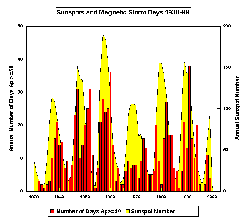
|
This figure shows the number of days per year where the geomagnetic
activity index "Ap" exceeded a value of 50. The Ap data is plotted
over the sunspot number index. It can be seen that geoeffective
solar events are more prevalent in the declining years of the sunspot
cycle. Figure is from Joe Hirman at NOAA via Xue Pu Zhao
|
 V. MDI Instrument Status
V. MDI Instrument Status
After 5 years of operation, MDI is basically working very well.
MDI has made about 50 million images. After on-board computations,
it has delivered about 8 million raw data images to the ground.
-
There is an expected degradation in total light throughput likely
due to changes in the front window. The reduction in transmission
to March 2001 was about 10%, or about 2.3% per year.
Plot of cal-mode
brightness.
Plot of front window temp.
-
There is a reduction in shutter exposure time uniformity from a part
in 12000 to a part in 4000. This corresponds to jitter of 40 microsec
for a 165 ms exposure. The pre-launch specification was 50 microseconds.
So, while still within the pre-launch requirement we will watch for
changes. There are is a low impact change to the observing sequence
that could reduce shutter usage by about 30%. This will be evaluated
if there are further changes. The change happened in March 2000.
-
There is no detected change in the CCD flat field except for variations
with focus change.
-
The drift in central wavelength of the Michelson's has nearly stopped.
-
The drift in best focus position has moved the nominal focus setting
back almost to the design point. Shortly after launch it was at the
limit of the adjustment range.
Plot.
-
The change in image scale (see
Plot)
is due to the focus change and window temperature.
The vertical lines in the plot show times of commanded focus change.
In summary, with the possible exception of the recently detected
shutter jitter, there is no known limit to MDI's useful life within
the SOHO expected fuel life.
 VI. MDI Data Processing
VI. MDI Data Processing
At the end of March 2001, the MDI data processing system,
SSSC (SOI Science Support Center), had archived 1.015 million datasets
containing 53.6 Terabytes of raw and processed data.
The MDI data center has responded to more than 6000 individual requests
for data amounting to about 8 Terabytes. Most requests are for multiple
datasets. Requests for MDI data processed through the SOHO archives at
GSFC and the remote SOHO archives in Europe are not shown here.
MDI Data Requests
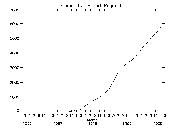
|
Left: Requests for MDI Data exports processed since Sept 1997.
Right: Cummulative volume of data exported from the MDI archive via
the Web interface at
http://soi.stanford.edu/data
|
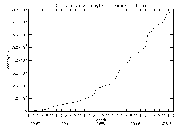
|
 VII. MDI Publication Record
VII. MDI Publication Record
For Dissertations see:
Dissertation List
For list of Proceedings see:
Conference Proceedings List
For list of Papers see:
Paper List
 VIII. MDI EPO Activities
VIII. MDI EPO Activities
Education and Public Outreach are important adjunct activities of the MDI
team. These activities include:
- Public lectures by several scientists at
Stanford, Lockheed-Martin, and Guest-Investigator institutions.
Lectures include local area astronomy clubs and public lecture series sponsored
by the California State Parks, as well as public colloquia at our own
institutions.
-
Development and maintenance of our public information web site at
http://solar-center.stanford.edu.
-
Development and distribution of informative and educational posters including
a constructable spectrometer. We have received more than 12,000 requests
for these posters with the majority of requests coming from educators.
We have distributed the posters via the web as well as at public events
such as "Astronomy Day" exhibits and school site visits.
-
Development and production of live
webcasts
in cooperation with the NASA's Learning Technologies Channel
program at NASA Ames Research Center.
-
Development of short videos to accompany the spectrometer poster. One
of these has been adopted by NASA as part of its core program materials
for distribution to schools.
-
Support for local schools with classromm visits by astronomers with
solar telescopes and spectral line emitting gas lamps.
-
Support of the "Project Astro" program by a number of members of the Stanford
and Lockheed teams.
 II. Previous Senior Review
II. Previous Senior Review II. Previous Senior Review
II. Previous Senior Review III. MDI Science Contributions
III. MDI Science Contributions IV. Proposed Investigations
IV. Proposed Investigations




 V. MDI Instrument Status
V. MDI Instrument Status VI. MDI Data Processing
VI. MDI Data Processing

 VII. MDI Publication Record
VII. MDI Publication Record VIII. MDI EPO Activities
VIII. MDI EPO Activities